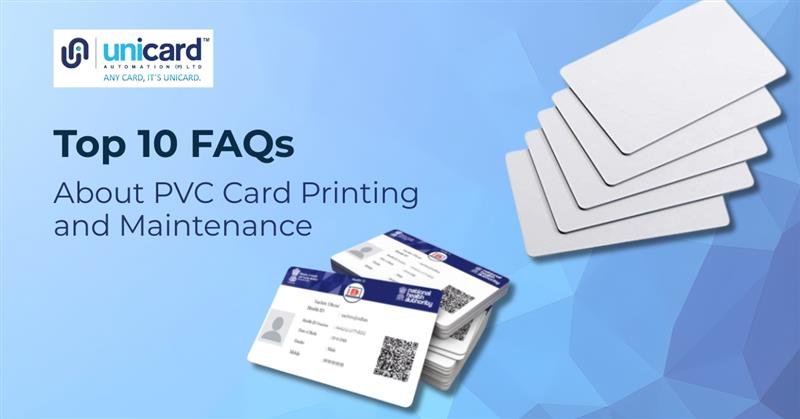PVC cards have become essential tools across countless industries, from corporate ID badges to membership cards and access control systems. Despite their widespread use, many people still have questions about how these durable plastic cards work, how to print them effectively, and how to keep them in top condition.
Whether you’re a business owner considering PVC cards for your organization or someone tasked with managing an existing card program, understanding the basics can save you time, money, and frustration. This guide addresses the most common questions we hear about PVC card printing and maintenance.
What are PVC cards made of?
PVC cards are constructed from polyvinyl chloride, a synthetic plastic polymer known for its durability and flexibility. Most standard PVC cards are composed of multiple layers fused together under heat and pressure, creating a solid, tamper-resistant structure.
The typical PVC card measures 3.375″ × 2.125″ (CR80 size) and is 30 mil thick—roughly the same dimensions as a credit card. This standardization ensures compatibility with card readers, printers, and accessories across different manufacturers.
What are common uses for PVC cards?
PVC cards serve numerous purposes across various industries. Employee ID badges remain the most popular application, providing visual identification and access control for workplaces. Membership cards for gyms, clubs, and loyalty programs represent another major use case.
Educational institutions rely on PVC cards for student IDs, library cards, and meal plan access. Healthcare facilities use them for patient identification and staff credentials. Gift cards, key cards for hotels, and even business cards benefit from PVC’s professional appearance and longevity.
How do I print on PVC cards?
Printing on PVC cards requires specialized card printers designed to handle the unique properties of plastic substrates. The most common printing method is dye-sublimation, which transfers colored dyes from a ribbon onto the card surface using heat.
Direct-to-card printing applies ink directly onto the PVC surface, while retransfer printing first prints onto a transfer film before applying it to the card. The choice depends on your quality requirements, volume needs, and budget constraints.
What type of printer is needed for PVC cards?
Dedicated card printers are essential for professional PVC card printing. Entry-level direct-to-card printers work well for basic applications and moderate volumes. These printers typically cost between $1,000 and $3,000.
For higher quality output and larger volumes, retransfer printers offer superior image quality and can print edge-to-edge. Industrial-grade printers handle thousands of cards daily and include advanced features like lamination modules and encoding capabilities for smart cards.
How do I store PVC cards properly?
Proper storage extends PVC card lifespan significantly. Store cards in a cool, dry environment away from direct sunlight, as UV exposure can cause fading and brittleness. Temperature fluctuations should be minimized—ideally between 60-70°F.
Keep cards flat and avoid bending or stacking heavy objects on top of them. For long-term storage, use protective sleeves or boxes designed specifically for cards. Avoid areas with high humidity, which can promote mold growth and adhesive failure in multi-layer cards.
What are the benefits of using PVC cards?
PVC cards offer exceptional durability compared to paper alternatives, typically lasting 3-5 years with regular use. They resist water, chemicals, and normal wear and tear, making them ideal for environments where paper cards would quickly deteriorate.
The professional appearance of PVC cards enhances brand image and perceived value. They can incorporate security features like holograms, magnetic stripes, or RFID chips for enhanced functionality. Cost-effectiveness improves with volume, as the per-card price decreases significantly for larger orders.
How can I prevent PVC card damage?
Prevention starts with proper handling. Avoid bending cards or exposing them to extreme temperatures. Clean cards regularly with a soft, lint-free cloth and mild soap solution—never use abrasive cleaners or solvents.
Protect cards from sharp objects and avoid storing them in wallets with coins or keys that could scratch the surface. For high-use applications, consider adding a protective overlay during printing to increase scratch resistance.
Are there different thicknesses of PVC cards?
Yes, PVC cards come in various thicknesses measured in mils (thousandths of an inch). Standard cards are 30 mil thick, matching credit card dimensions. Thicker options include 40 mil and 60 mil cards for applications requiring extra durability.
Thinner cards (20 mil) are available for temporary use applications where cost savings matter more than longevity. The thickness choice affects durability, perceived quality, and compatibility with certain card readers and printers.
Can PVC cards be recycled?
PVC cards can be recycled, though the process requires specialized facilities capable of handling PVC materials. Many card manufacturers now offer take-back programs for end-of-life cards, ensuring proper recycling through appropriate channels.
Some companies are exploring eco-friendly alternatives like biodegradable card materials or cards made from recycled plastics. However, traditional PVC remains the most practical choice for applications requiring durability and security features.
Where can I order custom PVC cards?
Custom PVC cards are available from numerous sources, including local print shops, online card printing services, and specialized card manufacturers. When choosing a supplier, consider factors like minimum order quantities, turnaround times, quality standards, and available customization options.
Many suppliers offer design assistance and can handle complex requirements like encoding magnetic stripes or embedding RFID chips. Request samples before placing large orders to ensure print quality meets your standards.
Streamlining Your PVC Card Operations
Understanding these fundamentals helps ensure successful PVC card implementation and maintenance. Proper planning, quality equipment, and good maintenance practices will maximize your investment in PVC card technology.
For organizations managing large-scale card programs, automation solutions like Unicard Automation can streamline the entire process from design to distribution. These comprehensive platforms integrate card printing, database management, and inventory tracking into a single, efficient workflow that reduces errors and saves valuable time.





